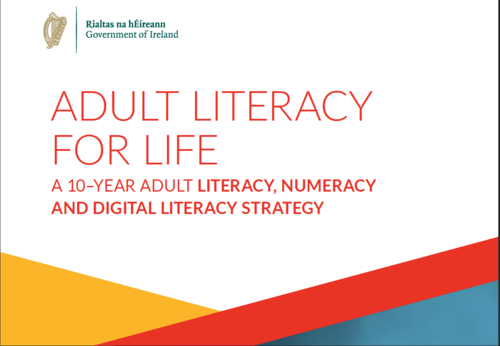On the 8th of September, 2021 the Adult Literacy for Life Strategy, a 10 year adult literacy, numeracy and digital literacy strategy, was launched with the intention of using pre-existing schools, institutions, and resources to make it:
- Easier for those with unmet literacy needs to ‘take the next step’.
- A more connected and accessible system that ensures access to all of the supports and services and a clear pathway to further develop skills.
- A responsive approach that offers increased learning and support opportunities for the rapidly changing world in which we live.
Implementation is to be rolled out in four phases represented by the four pillars; 1. Pillar One: Understand; 2. Pillar Two: Access; 3. Pillar Three: Expand; and 4. Pillar Four: Empower.
Pillar 1
This consists of a National Campaign, a One-stop-Shop website, Proactive Local Services, and a Standard Assessment Approach.
- The National Campaign consists of advertising on multiple media channels and for stakeholders to reinforce this campaign through their own available means.
- The One-stop-Shop is primarily for use by jobs coaches, administrators, case workers, etc. to easily link learners with the appropriate courses. Similar websites such as springboard.ie and fetchcourses.ie have shown that this approach can be successful.
- Proactive Local Services linking people with literacy deficits to education will be an important vector for getting people into literacy programmes. Being able to deal directly with people with literacy needs, local services are well situated to provide encouragement and support for people who may have had negative experiences of learning in the past.
- The use of a Standard Assessment Approach provides a clear picture of a learner’s needs and capabilities, and means that they can undertake an appropriate level of education.
Pillar 2
This pillar seeks to make education opportunities easier to find and to remove barriers to engaging with education. It includes: Plain Accessible Content, Access To Technology, Integrated Literacy Supports In Work And Education Settings, and Universal Design Approach.
- Plain Accessible Language is an effort across government bodies to produce documents in plain, easy to understand language in accordance with set guidelines. This also includes guidelines specific to provision for Irish language documentation, and adherence to pre-existing web/digital accessibility guidelines for accommodating disabilities.
- Access To Technology involves schemes to supply funding to ETBs and similar educational institutions to provide support devices, in addition to a recommendation to provide loan and/or tax credit schemes to facilitate people to access digital devices.
- Integrated Literacy Supports in Work and Education Settings will involve working with employers to provide learning supports for staff, providing literacy supports for students in ETBs and apprenticeships, and supports for those undertaking the Work Placement Scheme.
- Universal Design Approach refers to a set of standards and guidelines in multiple areas of provision, ranging from building regulations to the registration process.
Pillar 3
This pillar concerns the expanding of services, and includes four points: Focus on Numeracy, Drive Digital Competency, Support Skilled Practitioners, and Innovate and Enhance Provision.
- Focus on Numeracy entails the provision of numeracy programmes in ETBs, libraries and through other community learning organisations. In addition to vocation specific programmes as part of apprenticeships.
- Drive Digital Competency recommends using the EU DigComp framework to measure prospective learners’ digital literacy, availing of third party providers and pre-existing public providers to provide online supports for intermediate learners, and providing face-to-face learning through ETBs for beginners, along with more casual learning options.
- Under Support Skilled Practitioners the aim is to improve numbers and quality of literacy teachers. There are four key issues.
- Create a standard route to becoming a literacy teacher. Care will be needed to avoid shortages in areas lacking people with the appropriate skills.
- Put greater focus on a teacher’s continuing professional development and portfolio of skills.
- Clearly define the role and to standardise the role of literacy tutor across the country.
- Develop bite-sized courses, supports, and capability assessment tools for literacy teachers and others whose role requires them to provide literacy supports.
- There are several aims under the Innovate and Enhance Provision; increase literacy support capacity, provide for a variety of different learning styles, building on good practices already in use, learning from successful practices abroad, and using insight and expertise of Higher Education Institutions to improve provision.
Pillar 4
The last pillar consists of: Person-centred Pathways, Target Vulnerable Groups, Support Community Initiatives, and Link to Health and Well-being.
- Person-centred Pathways seeks to provide education suited to a learner’s needs and preferred learning style, along with removing barriers to participation through provision of childcare, transport expenses, etc.
- Target Vulnerable Groups aims to provide supports on a furthest behind first basis. Targeting groups such as persons with disabilities, members of the Traveller community, and long-term unemployed.
- Support Community Initiatives will involve creating regional coalitions which will be funded by the Mitigating Against Educational Disadvantage Fund, target literacy issues and collaborative working, put in place referral protocols across community, and work towards a non-intrusive registration system that focuses on tracking outcomes, identifying individual needs to shape support, and links to other relevant services.
- Link to Health and Well-Being is a recognition of the link between good health and wellbeing, the corelation between people with literacy needs and poor mental health, and the necessity for expanding the number of Crystal Clear pharmacies which explain in detail prescriptions and medications to customers with literacy needs.
The strategy aims to measure success in Literacy, Numeracy, and Digital Literacy with clearly defined goals in each area.
- Literacy: Decrease: the share of adults in Ireland with unmet literacy needs, that is PIAAC Level 1 or below, from 18% to 7%.
- Numeracy: Decrease the share of adults in Ireland with unmet numeracy needs, that is PIAAC Level 1 or below, from 25% to 12%.
- Digital Literacy: Decrease the share of adults in Ireland without basic digital skills from 47% to 20%.
